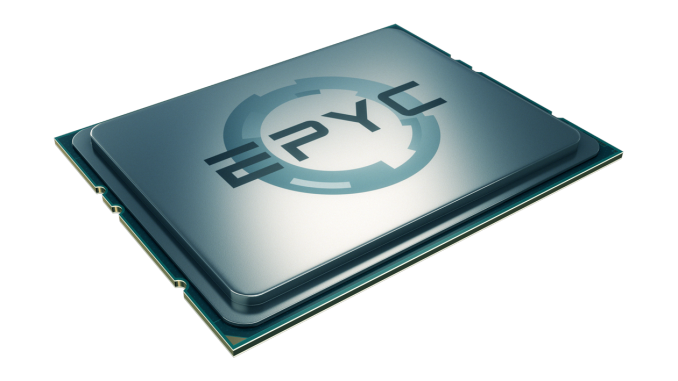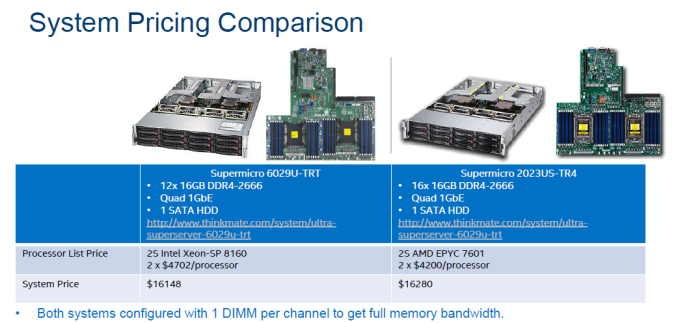Dissecting Intel's EPYC Benchmarks: Performance Through the Lens of Competitive Analysis
by Johan De Gelas & Ian Cutress on November 28, 2017 9:00 AM EST- Posted in
- CPUs
- AMD
- Intel
- Xeon
- Skylake-SP
- Xeon Platinum
- EPYC
- EPYC 7601

Although the AMD EPYC is definitely a worthy contender in the server space, AMD's technical marketing of the new CPU has been surprisingly absent, as the company not published any real server benchmarks. The only benchmarks published were SPEC CPU and Stream, with AMD preferring for its partners and third parties to promote performance. And, as our long-time readers know, while the SPEC CPU benchmarks have their merits and many people value them, they are a very poor proxy of most server workloads.
In every launch, we expect companies to offer an element of competitive analysis, often to show how their platform is good or better than the rest. At the launch of Intel's latest Xeon-SP platform, analysis to EPYC was limited to a high-level, as the systems were not as freely available as expected. AMD was able to do so on Broadwell-E at the time of the EPYC announcement because it was out and available - Intel wasn't able to do it on EPYC because AMD were several months away from moving it from a cloud-only ramp up program. This is partly the effect of AMD's server market implementation and announcement roadmap, although it didn't stop Intel from hypothesising about the performance deficits in ways that caught the attention of a number of online media.
Throughout all of this, AMD could not resist but to continue to tell the world that the "EPYC SoC Sets World Records on SPEC CPU Benchmarks". In the highly profitable field that is server hardware, this could not be left unanswered by Intel, who responded that the Intel Xeon Scalable has great "momentum" with no less than 110 performance records to date.
Jumping to the present time, in order to to prove Xeon-SP dominance over the competition, Intel's data center engineering group has been able to obtain a few EPYC systems and has started benchmarking. This benchmarking, along with justifications of third-party verification, was distributed to the small set of Xeon-SP launch reviewers as a guide, to follow up on that high-level discussion some time ago. The Intel benchmarking document we received had a good amount of detail however, and the conference call we had relating to it was filled with some good technical tidbits.
Our own benchmarks showed that the EPYC was a very attractive alternative in some workloads (Java applications), while the superior mesh architecture makes Intel's Xeon the best choice in other (Databases for example).
A Side Note About SPEC
A number of these records were achieved through SPEC. As mentioned above, while SPEC is a handy tool for comparing the absolute best tweaked peak performance of the hardware underneath, or if the system wants to be analysed close to the metal because of how well known the code base is, but this has trouble transferring exactly to the real world. A lot of time the software within a system will only vaguely know what system it is being run on, especially if that system is virtualised. Sending AVX-512 commands down the pipe is one thing, but SPEC compilation can be tweaked to make sure that cache locality is maintained whereas in the real-world, that might not be possible. SPEC says a lot about the system, but ultimately most buyers of these high-end systems are probing real-world workloads on development kits to see what their performance (and subsequent scale-out performance) might be.
For the purposes of this discussion, we have glossed over Intel's reported (and verified over at SPEC.org) results.
Pricing Up A System For Comparison
Professionals and the enterprise market will mention, and quite rightly, that Intel has been charging some heavy premiums with the latest generation, with some analysts mentioning a multiple jump up in pricing even for large customers, making it clear that the Xeon enterprise CPU line is their bread and butter. Although Intel's top-end Xeon Platinum 8180 should give the latest EPYC CPU a fit of trouble thanks to its 28 Skylake-SP cores running at 2.5 to 3.8 GHz, the massive price tag ($10009 for the standard version, $13011 for the high-memory model) made sure that Intel's benchmarking team had no other choice than also throwing in a much more modest Xeon Platinum 8160 (24 cores at 2.1 - 3.7 GHz, $4702k) as well as the Xeon Gold 6148 (20 cores at 2.4-3.7 GHz, $3072).
| SKUS Tested | |||||
| Intel Xeon Platinum 8180 |
Intel Xeon Platinum 8160 |
Intel Xeon Gold 6148 |
AMD EPYC 7601 |
||
| Release Date | Early Q3, 2017 | Late Q2, 2017* | |||
| Microarchitecture | Skylake-SP with AVX-512 | Zen | |||
| Process Node | Intel 14nm (14+) | GloFo 14nm | |||
| Cores / Threads | 28 / 56 | 24 / 48 | 20 / 40 | 32 / 64 | |
| Base Frequency | 2.5 GHz | 2.1 GHz | 2.4 GHz | 2.2 GHz | |
| Turbo | 3.8 GHz | 3.7 GHz | 3.7 GHz | 3.2 GHz | |
| L2 Cache | 28 MB | 24 MB | 20 MB | 16 MB | |
| L3 Cache | 38.5 MB | 33.0 MB | 27.5 MB | 64 MB | |
| TDP | 205 W | 150 W | 150 W | 180 W | |
| PCIe Lanes | 48 (Technically 64 w/ Omni-Path Versions) | 128 | |||
| DRAM | 6-channel DDR4 | 8ch DDR4 | |||
| Max Memory | 768 GB | 2048 GB | |||
| Price | $10009 | $4702 | $3072 | $4200 | |
As a result of this pricing, one of the major humps for Intel in any comparison will be performance per dollar. In order to demonstrate that systems can be equivalent, Intel offered up this comparison from a single retailer. Ideally Intel should have offered multiple configurations options for this comparison, given that a single retailer can intend for different margins on different sets of products (or have different levels of partnership/ecosystem with the manufacturers).
Even then, price parity could only be reached by giving the Intel system less DRAM. Luckily this was the best way to configure the Intel based system anyway. We can only guess how much the benchmarking engineers swore at the people who set the price tags: "this could have been so much easier...". All joking apart, the document we received had a good amount of detail, and similar to how we looked into AMD's benchmarking numbers at their launch, we investigated Intel's newest benchmark numbers as well.











105 Comments
View All Comments
smilingcrow - Tuesday, November 28, 2017 - link
TSX has been implemented but how about ASF?CajunArson - Tuesday, November 28, 2017 - link
Incidentally, for anybody who think Intel "cheated" with those numbers there's concrete proof from independent third-party reviewers that at least the GROMACS benchmark results that Intel itself is showing are not fully accurate... as in they are not fully accurate in *AMD's favor*.Here's a link to GROMACS results from Serve the Home that are actually using the newest version that finally turns on the AVX-512 support to show you what the Xeon platform was actually designed to do: https://www.servethehome.com/wp-content/uploads/20...
So just remember that Intel is being pretty conservative with these numbers if their own published GROMACS results are anything to go by.
MonkeyPaw - Tuesday, November 28, 2017 - link
I would hope they’d be conservative in this sector. I’m guessing very knowledgeable people will be making the buying decisions here, and there may even be contractual expectations from the purchasing companies. Over promising and under delivering on an internal report might not just cost a few big sales, they might even result in lawsuits.tamalero - Tuesday, November 28, 2017 - link
I think the problem is while intel usually uses the most optimized compilers and systems. They usually do not optimize the intel systems at all. At least in the consumer benchmarks.Not so sure about these enterprise because I have no idea what most of these tests do.
jjj - Tuesday, November 28, 2017 - link
The biggest lie is through omission, the bulk of the volumes is at rather low ASP so if you are gonna test test 1k$ and bellow SoCs and use the I/O offered by each.eek2121 - Tuesday, November 28, 2017 - link
I would be interested to see how AMD EPYC processors with lower core counts perform in the database benchmarks, as they should have few NUMA nodes.CajunArson - Tuesday, November 28, 2017 - link
Wrong. You clearly don't understand how Epyc works. Literally every Epyc chip has the same number of NUMA nodes regardless of core count from the 7601 all the way down to the super-stripped down parts.Each chip has 4 dies that produce the same number of NUMA nodes, AMD just turns off cores on the lower-end parts.
Maybe you should have actually learned about what Epyc was instead of wasting your time posting ignorant attacks on other people's posts.
eek2121 - Tuesday, November 28, 2017 - link
The same goes for you. My ignorance with EPYC stems from poor availability and the lack of desire to learn about EPYC. You seem to have a full time job trolling on AnandTech. Go troll somewhere else.IGTrading - Tuesday, November 28, 2017 - link
Chill guys :)Reading your posts I see you're both right, just using examples of different use cases.
P.S. Cajun seems like a bit of an avid Intel supporter as well, but he's right : in AVX512 and in some particular software, Intel offers excellent performance.
But that comes at a price, plus some more power consumption, plus the inability to upgrade (considering what Intel usually does to its customers) .
iwod - Tuesday, November 28, 2017 - link
poor availability - do dell offer AMD now?